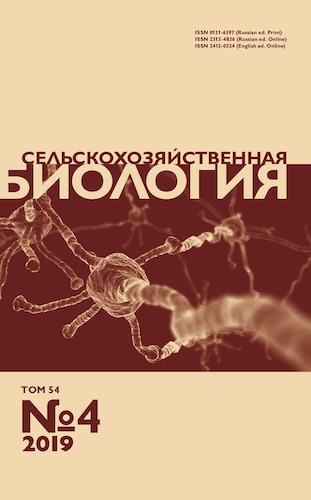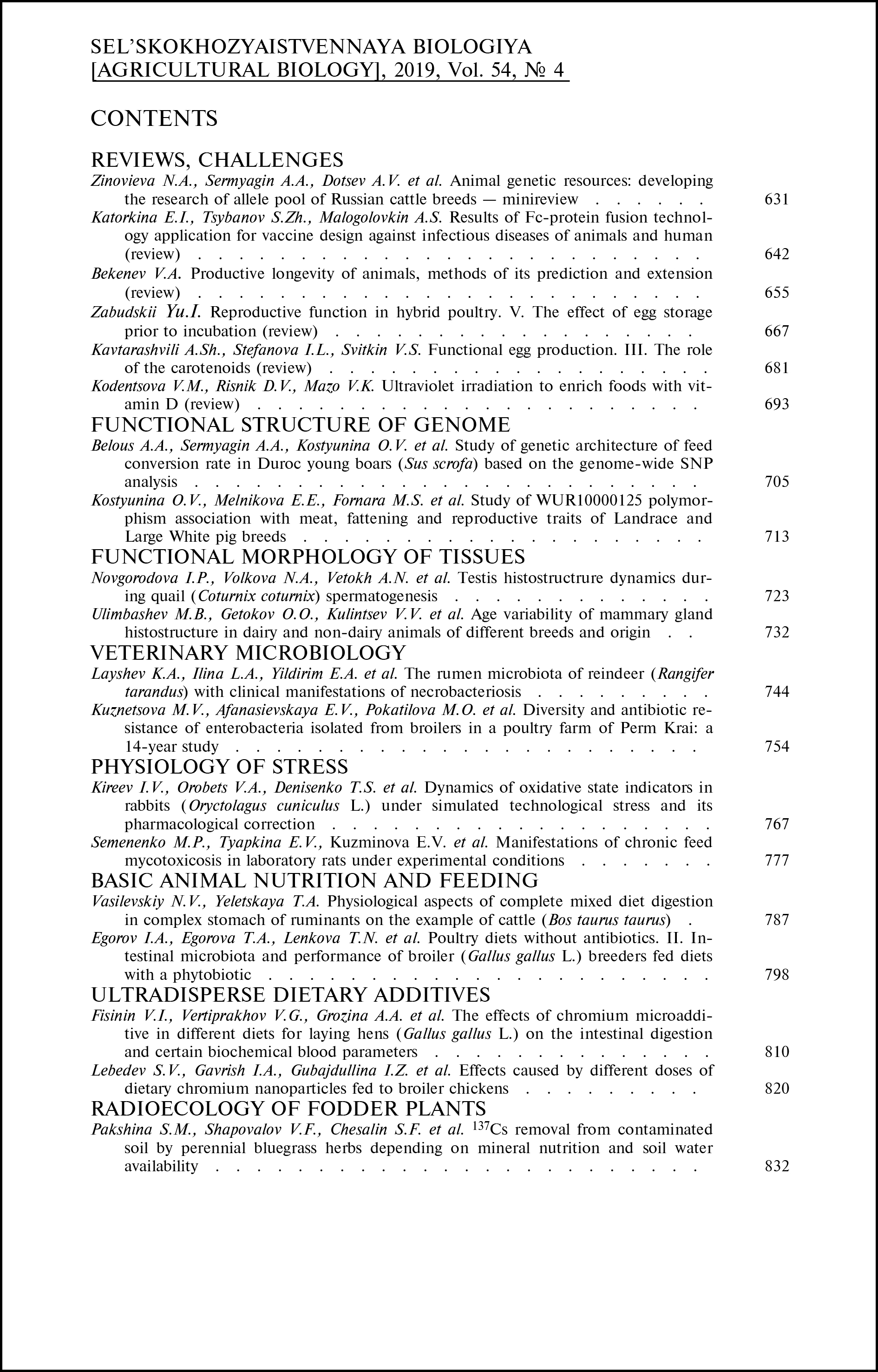doi: 10.15389/agrobiology.2019.4.705eng
UDC: 636.4.033:636.082.12:575.113
Acknowledgements:
The equipment of the Center for Biological Resources and Bioengineering of Farm Animals (Ernst Federal Science Center for Animal Husbandry)was used for the study.
Supported financially by the Ministry of Education and Science of the Russian Federation, a unique project number RFMEFI60417X0182
STUDY OF GENETIC ARCHITECTURE OF FEED CONVERSION RATE IN DUROC YOUNG BOARS (Sus scrofa) BASED ON THE GENOME-WIDE SNP ANALYSIS
A.A. Belous1, A.A. Sermyagin1, O.V. Kostyunina1, G. Brem2,
N.A. Zinovieva1
1Ernst Federal Science Center for Animal Husbandry, 60, pos. Dubrovitsy, Podolsk District, Moscow Province, 142132 Russia, e-mail belousa663@gmail.com, alex_sermyagin85@mail.ru, kostolan@yandex.ru, n_zinovieva@mail.ru (✉ cor-responding author);
2Institut für Tierzucht und Genetik, University of Veterinary Medicine (VMU), Veterinärplatz, A-1210, Vienna, Austria, e-mail gottfried.brem@agrobiogen.de
ORCID:
Belous A.A. orcid.org/0000-0001-7533-4281
Brem G. orcid.org/0000-0002-7522-0708
Sermyagin A.A. orcid.org/0000-0002-1799-6014
Zinovieva N.A. orcid.org/0000-0003-4017-6863
Kostyunina O.V. orcid.org/0000-0001-8206-3221
Received February 18, 2019
Feed conversion (feed conversion ratio — FCR, kg/kg), calculated as the ratio of the amount of feed intake to the body weight gain, is the most important trait that determines the economic efficiency of pork production. The development of automated feeding stations allows researchers to carry out an accurate individual measurements of feed intake in the group-housed pigs, which became the basis for the integration of the FCR in the breeding programs. The development of high-throughput genotyping methods for tens of thousands of single-nucleotide polymorphisms (SNPs) made it possible to identify genetic factors associated with economically important animal traits at genome-wide level. Previous studies, performed in different pig breeds have shown the presence in the genome of the pig of multiple QTLs for FCR, while the regions of the genome identified in different studies were only partially overlapped. In this report, we present the genome-wide association studies results in one of the Russian Duroc boar population, which revealed the presence of 30 SNPs that were significantly associated with the feed conversion rate, as well as positional and functional candidate genes whose products are involved in the regulation of proliferation and differentiation various types of cells in lipid hematopoiesis and metabolism. The aim of the present work was to study the genetic factors affecting the feed efficiency in Duroc young boars, phenotyped individually for feed conversion rates and genotyped by ~ 70 thousand single-nucleotide polymorphisms at the genome-wide level. The study was performed on 715 young Duroc boars marked with electronic chips. Individual values of feed intake were recorded using automatic feeding stations MLP-RAP («Schauer Agrotronic AG», Switzerland) and GENSTAR («Cooperl Arc Atlantique», France). Genotyping was performed using a high-density DNA chip GGP Porcine HD (GeneSeek Genomic Profiler platform, Neogene, USA) containing of ~ 70 thousand SNPs. After quality control, 44810 SNPs were selected for genome-wide association studies (GWAS). Average daily gain (ADG) in the studied pigs amounted to 962.04±5.06 g/day, and feed conversion (FCR) was 2.53±0.2 kg/kg. Based on the GWAS analysis, 30 significant (p < 0.00001) SNPs localized at SSC2, SSC3, SSC4, SSC6, SSC7, SSC12 and SSC15 were identified, including three genome-wide significant SNPs, the H3GA0010441 (p < 4.14×10-7), ALGA0119936 (p < 1.03×10-6) on SSC3, and ASGA0028727 (p < 1.17×10-6) on SSC6. At SSC2, SSC6 and SSC15, the SNPs’ blocks, consisting 10 (in the region of 29.0-30.9 cM, Sscrofa genome assembly 10.2), 7 (79.1-80.3 cM) and 3 SNPs (69.3-70.7 cM), respectively, were identified. Annotation of candidate genes localized in close proximity to significant SNPs revealed genes whose products are involved in heterogeneous biological processes, such as regulation of proliferation and differentiation of different cell types, hematopoiesis, lipid metabolism. The additional studies aimed at validation of detected associations in other populations of pigs are necessary. Identification of novel QTLs for feed conversion rate will enhance our understanding of the genomic architecture of this important breeding trait.
Keywords: genome-wide association studies, feed conversion rate, average daily gain, back fat, Duroc boars.
REFERENCES
- Kanis E., De Greef K.H., Hiemstra A., van Arendonk J.A. Breeding for societally important traits in pigs. J. Anim. Sci., 2005, 83(4): 948-957 CrossRef
- Ito T., Fukawa K., Kamikawa M., Nikaidou S., Taniguchi M., Arakawa A., Tanaka G., Mikawa S., Furukawa T., Hirose K. Effects of correcting missing daily feed intake values on the genetic parameters and estimated breeding values for feeding traits in pigs. Animal Science Journal, 2018, 89: 12-20 CrossRef
- Hoque M.A., Suzuki K. Genetic parameters for production traits and measures of residual feed intake in Duroc and Landrace pigs. Animal Science Journal,2008, 79: 543-549 CrossRef
- Hoque M.A., Suzuki K., Kadowaki H., Shibata T., Oikawa T. Genetic parameters for feed efficiency traits and their relationships with growth and carcass traits in Duroc pigs. Journal of Animal Breeding and Genetics, 2007,124(3): 108-116 CrossRef
- Maselyne J., Saeys W., Van Nuffel A. Quantifying animal feeding behaviour with a focus on pigs. Physiol. Behav., 2015, 138: 37-51 CrossRef
- Schulze V., Roehe R., Looft H., Kalm E. Effects of continuous and periodic feeding by electronic feeders on accuracy of measuring feed intake information and their genetic association with growth performances. Journal of Animal Breeding and Genetics, 2001, 118: 403-416 CrossRef
- Lorenzo Bermejo J., Roehe R., Schulze V., Looft H., Kalm E. Genetic change of feed intake curves in growing pigs using non-linear two-stage genetic analysis and linear random regression models. Journal of Animal Breeding and Genetics, 2003, 120: 217-227 CrossRef
- Do D.N., Strathe A.B., Jensen J., Mark T., Kadarmideen H.N. Genetic parameters for different measures of feed efficiency and related traits in boars of three pig breeds. J. Anim. Sci., 2013, 91(9): 4069-4079 CrossRef
- Brown-Brandl T., Rohrer G., Eigenberg R. Analysis of feeding behavior of group housed growing-finishing pigs. Computers and electronics in agriculture, 2013, 96(1): 246-252 CrossRef
- Belous A.A., Sermyagin A.A., Kostyunina O.V., Trebunskikh E.A., Zinov'eva N.A. Study of genetic and environmental factors, characterizing the feed efficiency in Duroc pigs. Sel'skokhozyaistvennaya biologiya [Agricultural Biology], 2018, 53(4): 712-722 CrossRef
- Chen Y., Piper E., Zhang Y., Tier B., Graser H.U., Luxford B.G., Moran C. A single nucleotide polymorphism in suppressor of cytokine signalling-2 is associated with growth and feed conversion efficiency in pigs. Animal Genetics, 2011, 42(2): 219-221 CrossRef
- Duthie C., Simm G., Doeschl-Wilson A., Kalm E., Knap P.W., Roehe R. Quantitative trait loci for chemical body composition traits in pigs and their positional associations with body tissues, growth and feed intake. Animal Genetics, 2008, 39(2): 130-140 CrossRef
- Oliveira Peixoto J., Facioni Guimaraes S.E., Savio Lopes P., Menck Soares M.A., Vieira Pires A., Gualberto Barbosa M.V., Almeida Torres R., Almeida e Silva M. Associations of leptin gene polymorphisms with production traits in pigs. Journal of Animal Breeding and Genetics, 2006, 123: 378-383 CrossRef
- Pig QTL Data Base. Available http://www.animalgenome.org/cgi-bin/QTLdb/SS/index. Accessed 11.03.2019.
- Houston R.D., Haley C.S., Archibald A.L., Rance K.A. A QTL affecting daily feed intake maps to Chromosome 2 in pigs. Mamm. Genome, 2005, 16: 464-470 CrossRef
- Zhang Z.Y., Ren J., Ren D.R., Ma J.W., Guo Y.M., Huang L.S. Mapping quantitative trait loci for feed consumption and feeding behaviors in a White Duroc ½ Chinese Erhualian resource population. J. Anim. Sci., 2009, 87(11): 3458-3463 CrossRef
- Gilbert H., Riquet J., Gruand J., Billon Y. Detecting QTL for feed intake traits and other performance traits in growing pigs in a Piétrain—Large White backcross. Animal, 2010, 4(8): 1308-1318 CrossRef
- Shirali M., Duthie C.-A., Doeschl-Wilson A., Knap P.W., Kanis E., van Arendonk J.A., Roehe R. Novel insight into the genomic architecture of feed and nitrogen efficiency measured by residual energy intake and nitrogen excretion in growing pigs. BMC Genetics, 2013, 14: Article number 121 CrossRef
- Sahana G., Kadlecová V., Hornshøj H., Nielsen B., Christensen O.F. A genome-wide association scan in pig identifies novel regions associated with feed efficiency trait. J. Anim. Sci., 2013, 91: 1041-1050 CrossRef
- Wang K., Liu D., Hernandez-Sanchez J., Chen J., Liu C., Wu Z., Fang M., Li N. Genome wide association analysis reveals new production trait genes in a male Duroc population. PLoS ONE, 2015, 10: e0139207 CrossRef
- Ding R., Yang M., Wang X., Quan J., Zhuang Z., Zhou S., Li S., Xu Z., Zheng E., Cai G., Liu D., Huang W., Yang J., Wu Z. Genetic architecture of feeding behavior and feed efficiency in a Duroc pig population. Front. Genet., 2018, 9: 220 CrossRef
- Guo Y.M., Zhang Z.Y., Ma J.W., Ai H.S., Ren J., Huang L.S. A genomewide association study of feed efficiency and feeding behaviors at two fattening stages in a White Duroc ½ Erhualian F population. J. Anim. Sci., 2015, 93(4): 1481-1489 CrossRef
- Reyer H., Shirali M., Ponsuksili S., Murani E., Varley P.F., Jensen J., Wimmers K. Exploring the genetics of feed efficiency and feeding behaviour traits in a pig line highly selected for performance characteristics. Molecular Genetics and Genomics: MGG, 2017, 292(5): 1001-1011 CrossRef
- Turner S.D. qqman: an R package for visualizing GWAS results using Q-Q and Manhattan plots. Journal of Open Source Software, 2018, 3(25): 731 CrossRef
- Kagura J., Adair L.S., Munthali R.J., Pettifor J.M., Norris S.A. association between early life growth and blood pressure trajectories in Black South African children. Hypertension, 2016, 68(5): 1123-1131 CrossRef
- Bhattarai S., Nielsen J.P. Association between hematological status at weaning and weight gain post-weaning in piglets. Livestock Science, 2015, 182: 64-68 CrossRef
- Serem J.K., Wahome R.G., Gakuya D.W., Kiama S.G., Gitao G.C., Onyango D.W. Growth performance, feed conversion efficiency and blood characteristics of growing pigs fed on different levels of Moringa oleifera leaf meal. Journal of Veterinary Medicine and Animal Health, 2017, 9(11): 327-333 CrossRef
- Clapperton M., Bishop S.C., Cameron N.D., Glass E.J. Associations of acute phase protein levels with growth performance and with selection for growth performance in Large White pigs. Animal Science, 2005, 81(2): 213-220 CrossRef












